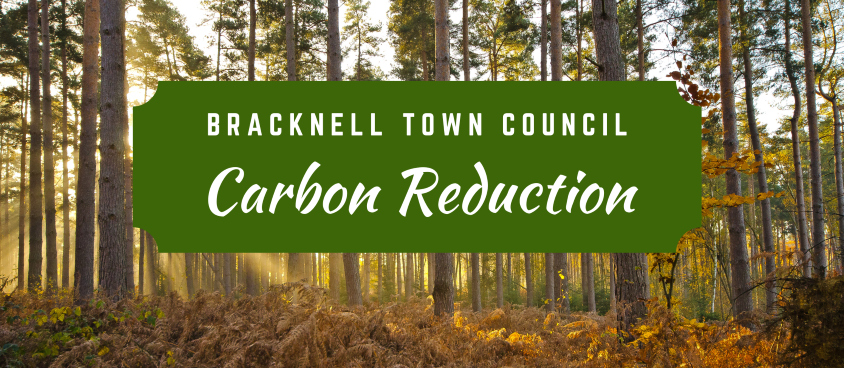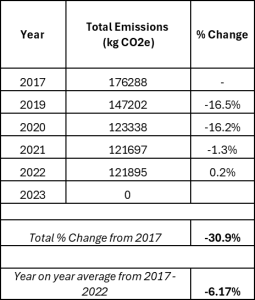Carbon Reduction Plan
Carbon Reduction Overview
Introduction
Bracknell Town Council manages 36+ parks, play areas and sports pitches, comprising over 250 acres of green space. BTC also manages:
- Organising free community events such as the Summer of Fun and Remembrance Parade
- 8 allotment sites
- Larges Lane cemetery
- 2 coffee shops
- 4 pavilions, 2 depots, 1 office and 2 changing room blocks
- Annual Grants for local organisations
- TV Grant Scheme
- Some bus stops and benches
There are 28 Bracknell Town Councillors covering 13 wards within the Bracknell Town area. These Councillors are volunteers and attend meetings to decide how BTC spends public money responsibly.
The Carbon Reduction Working Group meets 3-4 times per year to discuss the progress of reducing BTC’s carbon footprint. This is the overview for the Working Group detailing the priorities of BTC.
Aim
To achieve an average annual carbon footprint reduction of 2.5% from our operation
What BTC Are Already Doing
- Reducing plastic usage in our pavilion shops
- Leasing electric vehicles for our grounds team
- Sourcing renewable energy for our utilities
- Installing solar panels onto our buildings where possible
- Replacing old boilers for energy-efficient or alternative models
- Printing less in the office to use less paper
- Sending emails rather than sending letters
- Planting areas of wildflower meadows to encourage biodiversity
- Installing sensor lighting where possible
- Installing drinking fountains to encourage the re-filling of water bottles in our most used parks
- Commissioned an energy efficiency survey completed on all sites to assist with planning improvements
- Planting a minimum of 200 whips per year
- All BTC waste is either recycled or used to create energy via the Re3 Centre in Colnbrook. You can see what happens to our waste here: re3 Material streams (fccenvironment.co.uk)
BTC Commitments
- Maintain a Carbon Reduction Working Group(CRWG)
- Ensure that we have an annual Carbon Reduction Action Plan (CRP) in place to monitor the progress of all actions taken
- Ensure that the CRWG meets at four times per year to review the CRP and present carbon reduction recommendations to the Environmental Services Committee
- Measure and publish energy figures for the previous year on our website, which is defined as:
- Energy, water and fuel consumption in our buildings (monitored via utility bills and meter data)
- Fuel consumption by the council’s vehicle fleets and machinery (monitored via fuel records)
- This will be prepared and published when the final energy figures for the year are available
- Ensure at least 99% of our waste is diverted from landfill by reducing our waste, recycling, and reusing where possible
- Improve BTC building carbon efficiency in terms of using energy-efficient boilers, solar panels and PIR where possible
- Invest in energy-efficient equipment, such as electric vehicles, machinery and tools where possible
- Use sustainable green energy sources when agreeing to energy contracts
- Reduce the use of plastics within our coffee shops
- Maintain a minimum annual tree-planting programme of at least 200 whips
- When procuring items or services, ensure the organisations are using sustainable materials and are as eco-friendly as possible
- Promote carbon reduction awareness to Councillors, staff, residents and partners
- Ensure BTC operates within all environmental regulations imposed by UK law
- Review this policy document once in every election cycle to ensure that it continues to meet our aim and local priorities.
Small Actions Make Big Changes
BTC is already doing a lot to reduce its carbon emissions each year, however, there are small, cost-effective ways in which we can make a big difference to biodiversity and the environment at our sites. The Town Clerk and RFM met with a scientist from Wisley RHS and some of the ideas to focus on were:
- Plant more hedges or ‘tredges’
- Hedges reduce groundwater levels during periods of high rain
- Act as a barrier to noise pollution
- Excellent wildlife habitats and corridors
- ‘Tredges’ are trees and hedges: Plant trees with hedges underneath for multi-level carbon reduction and habitats
- Create miniature gardens
- Keep it green
- Don’t pave areas where possible
- Planting anything helps the environment, keep a good proportion of planting evergreen
- Add signage to small projects that help with carbon reduction and biodiversity
- Educate the residents to explain how they can replicate these small projects at home
- Leave wood debris and leaf piles in place where safe to do so, to decompose and form more habitats – and habitat piles
Priorities
- Continue the actions already being done by BTC with the daily tasks
- Plan some of the small changes above into new projects and planned work taking place with signage
- When older equipment is at the end of its life, replace it with a green alternative if possible (battery or electric-powered)
- The Energy Champion (Finance Officer) will focus on green energy suppliers as utility contracts are up for renewal in April and October
- To investigate a Biodiversity Action Plan including the costs and advantages.
Our latest Energy Figures:
(Note: There are no 2018 figures as data was originally calculated every 2 years, BTC are awaiting final 2023 figures)


